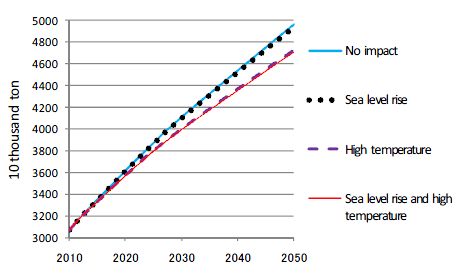Necessary conditions for long-term food security in Bangladesh under the influence of climate change
Description
Bangladesh, where rice is important as a staple, has achieved self-sufficiency in rice by introducing irrigation and high-yield varieties. However, it is not clear whether the country can produce enough rice in the future when high population growth and climate change will have more impacts on the country. Therefore, using a rice supply-demand model integrated with other models of environmental impacts on rice, we project future rice production, per capita consumption, and necessary conditions for long-term food security.
Comparison on the significance of impact on production between two factors such as increases in sea level and temperature rise shows that high temperature has a more serious effect than sea level rise from the viewpoint of national food security (Fig. 1). This implies that adaptation strategies should be taken for local food security in the coastal regions and for national food security in interior rice-producing regions. Comparison of the technical levels of rice production shows that moderate yield increase rates (1% for rainy seasons and 2% for dry season) cannot maintain per capita consumption under a heavy climate change scenario (Fig. 2 (a)). On the other hand, a high yield growth can help avoid reduction in per capita consumption even under a heavy climate change scenario (Fig. 2 (b)). This implies that sustainable high yield growth will be necessary to ensure national food security in this era of climate change, and annual growth rates of 1.5% for rainy seasons and 3% for dry season are identified as the ideal targets for research and development.
The analysis above is based on climate change impact projections supplied by other models, CERES-Rice (rice yield), MIKE21 (sea level rise) and MIKE11-GIS (flood). The supply-demand model developed for this analysis can be used for simulating the effects of research and development for rice production. Quantification of the CO2 fertilization effect and implementation of stochastic analysis will be the next tasks for model development.
Figure, table
-
Fig. 1. Rice production by type of impacts.
Temperature rise has a larger impact than increase in sea level on the national production level. -
Fig. 2. Per capita rice consumption by yield scenario and climate change scenario.
Under moderate yield growth (a), consumption decreases due to heavy climate change. High yield growth (b) can avoid the reduction even in heavy climate change scenario.
- Affiliation
-
Development Research Division
- Classification
-
Administration B
- Term of research
-
FY2009~2010
- Responsible researcher
-
KOBAYASHI Shintaro ( Development Research Division )
FURUYA Jun ( Development Research Division )
YAMAMOTO Yukiyo ( Development Research Division )
ISLAM Rafiqul ( Bangladesh Rice Research Institute )
SIDDIQUE Abu Bakr ( Bangladesh Rice Research Institute )
- ほか
- Publication, etc.
-
Kobayashi and Furuya. (2010)Papers on environmental information science 24:387-392.
- Japanese PDF


